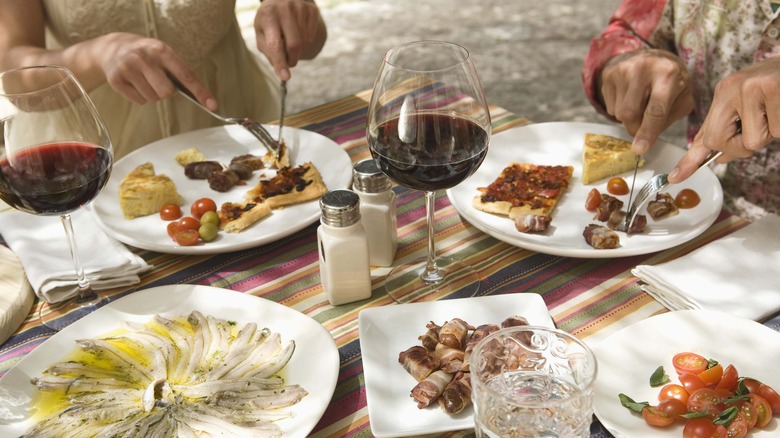The Word 'Tapas' Originally Had Nothing To Do With Specific Foods
As is often the case in the history of language, a word can begin its life with one definition and, over the course of decades or even centuries, go on to pick up many more. Such is the case with the word "tapas." While we all know tapas as the Spanish tradition of serving small plates of delicious food alongside drinks, the original meaning of the word meant something completely different.
Far from referring to specific types of food, the original definition of tapas was much more singular and practical. In Spanish, the word tapa is a derivative of the verb tapar, which means "to cover." Therefore, the literal translation of tapa is "lid". So, it is in keeping with the actual definition of the word that tapas makes its introduction to food.
You see, tapas became regular bar vernacular by food being used as a physical lid for drinks. It is generally believed that tapas were originally pieces of bread or sandwiches that bartenders placed on top of a drink as a way of preventing flies or other airborne particulates from getting into the liquid. It's as practical use as any for a slice of bread. So, how on earth did it go from protection from insects to the flights of food we all know today?
From flies to flights
It may be hard to see exactly how tapas went from food being used as an edible drink lid to the culinary tradition it is today. But the thread, however thin, is there. One of the more popular tales of how tapas came into being actually comes from the 13th century. The then King of Spain, Alfonso X, was recovering from an unnamed illness when his physicians had prescribed him a regiment of copious wine drinking accompanied by small portions of food. The food was intended to stave off drunkenness and enhance the wine's medicinal benefits. Apparently, this cured him. The King then declared that all households in Spain should eat small portions of food alongside their beverages as a means of preventing alcoholic intoxication.
It's also been theorized that medieval laborers kept small, portable, cheap lunches on them that could be eaten relatively quickly so as not to harm their productivity. These were things like olives, bits of cheese, sausages, and bread — not all that different from what you'd find on tapas plates today.
Either tale could be true. It could also be true that bar patrons enjoyed eating their small beverage lids and asked for more once they'd finished. Bartenders took advantage of the potential for more business, morphing the original purpose of tapas into beloved traditional dishes like pan con tomate, pescado frito, bombas, empanadas, and gazpacho. As far as definition changes go, this one has to be the most flavorful.

